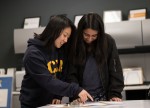The upcoming Designathon will help students devise creative and applicable solutions to everyday problems.
The second annual Designathon, hosted by Bruin Entrepreneurs, will be held Saturday in Carnesale Commons. Students have to apply online to participate. The beginner-friendly event will include computer design workshops and a daylong competition to familiarize students with the design thinking process, with this year’s event focusing on user experience design. The winning groups will earn design-related prizes, including Sketch software licenses and Wacom drawing tablets. Designathon co-director Natasha Puthukudy, a second-year design media arts student, said while knowing how to use software such as Sketch is necessary to be an efficient designer, the event will be more focused on teaching students the design process.
Puthukudy said the Designathon differs from last year’s by putting a greater emphasis on fostering “design thinking,” as opposed to providing exposure to different fields of design. Co-director Tiffany Yu, a fourth-year cognitive science student, said design thinking is a multistep process of understanding a user’s problems and creating a solution to cater to those needs. Puthukudy said continuously iterating and improving upon a design is a crucial part of the process.
“Being able to make something and go back and refine it makes your ideas a lot stronger,” Puthukudy said. “If you’re looking at things from a more creative lens, I feel like you can think of solutions that wouldn’t necessarily be the most straightforward, but would end up being more successful.”
[RELATED: Design media arts students put on rule-bending exhibit with mixed art forms]
While last year’s Designathon provided separate tracks for graphics and user experience design, Puthukudy said the upcoming event would be more focused on guiding students through each step of the design process. Last year, judging two separate topics split into beginner and advanced sections proved logistically difficult, but this year’s event has a more streamlined approach, she said.
For instance, the inaugural Designathon had six workshops covering different topics that sometimes overlapped with one another, meaning some students missed out on workshops they were interested in. This year’s, however, will have three separate workshops throughout the day, each focused on a specific step in the design thinking process, from inception to creation.
The first workshop will be hosted by aerospace company Northrop Grumman and will focus on empathizing, which involves understanding the user’s wants and needs. The second workshop, to be hosted by Ticketmaster, will help participants visualize how their product will fit into a user’s world by designing a magazine cover. Yu said the magazine cover will help students envision what their product would look like and how users should perceive it. The third and final workshop, to be hosted by Creative Labs UCLA, a student organization that bridges design and product development, will teach students how to prototype, creating a basic interactive model of their product. Puthukudy said the workshops will build off each other to help students design their solution to the competition prompt, which will be revealed at the event. As opposed to the three hours given last year, students will be working on their solutions throughout the day, she said.
Yu said the event will focus on circular design, which is emphasized throughout the branding for the event, including Designathon’s website and promotional images. Circular design was popularized by the design company IDEO, a leader in human-centered design. It revolves around the idea that design is iterative rather than linear, meaning that one continuously goes back in a circular manner to improve their design to satisfy the user. Yu added circular design also involves considering the ecological impact of one’s design. Circular design was born from the idea of a circular economy, where resources are continuously reused, Yu said.
“When you’re designing products or services, you design it with the mindset that it should be good for the people, the planet and business,” Yu said. “So understanding that all of those things are kind of tied together is the underpinning of circular design.”
[RELATED: Designathon encourages collaboration of students with diverse experience, perspectives]
Students, regardless of their major, should understand how human-centered design contributes to everything people interact with on a daily basis, Puthukudy said. Violet Guo, a first-year financial actuarial mathematics student, said she wishes to learn more about graphic design at Designathon to improve her digital art skills. As an artist who specializes in Chinese traditional painting, Guo said her genre of work is not especially popular in Western societies. By learning to transfer her work to a digital medium, Guo said she could help make Chinese traditional painting more accessible to a wider audience. She added that although graphic design is not directly related to her field of study, being able to create design that is simple and easy to understand is a valuable skill.
Puthukudy said even if one does not intend to specialize in design, being familiar with the process is useful, since it focuses on the user and attempts to solve problems. If at least a few students walk away from the event understanding how design thinking can be applied to their future career path, Yu said she will consider the event a success.
“Design thinking is a mindset for problem-solving that’s not only restricted to (user experience) design and product design,” Yu said. “It’s a problem-solving mindset that’s permeating every industry right now, and it’s the pillar of innovation.”
